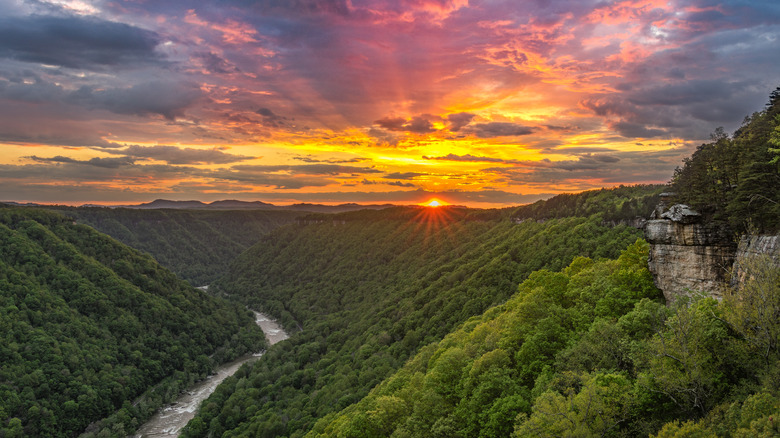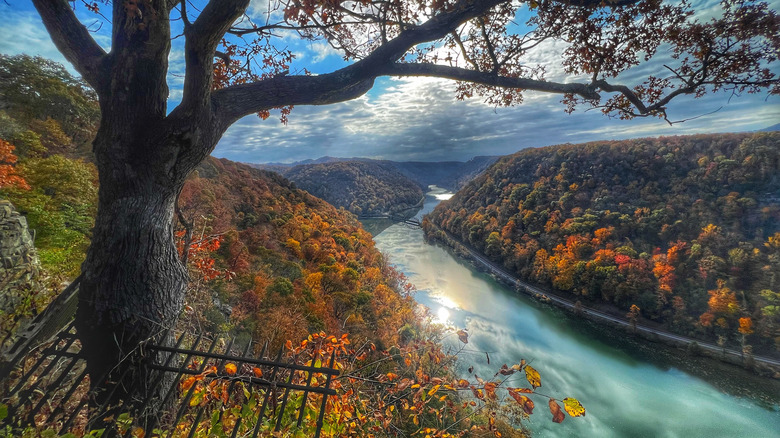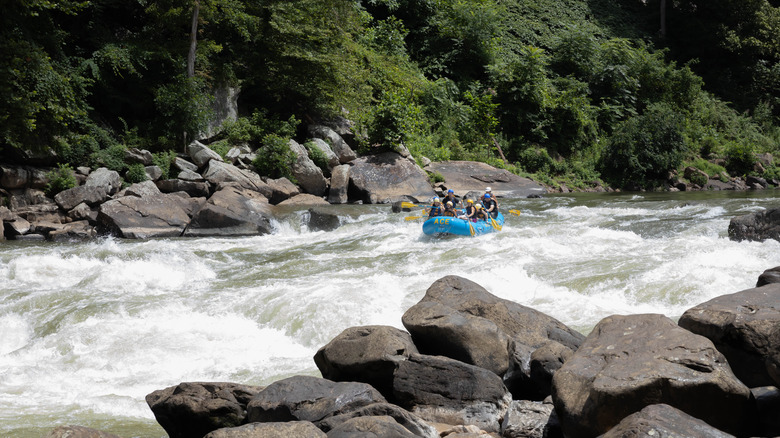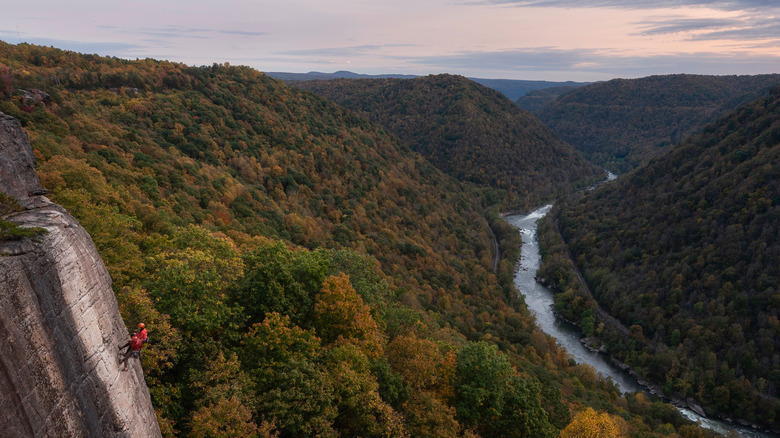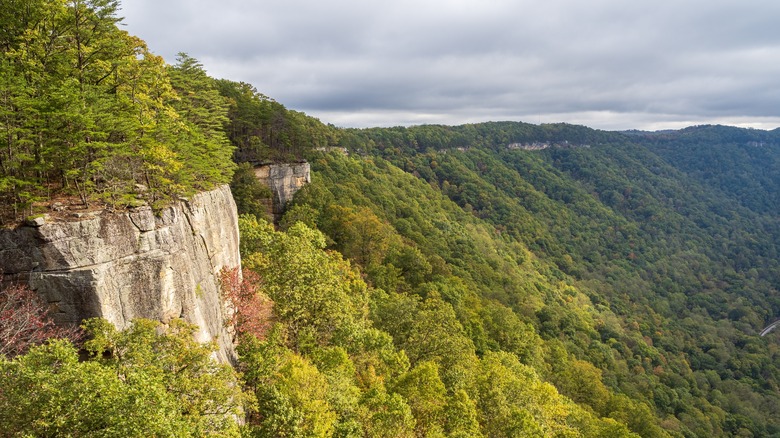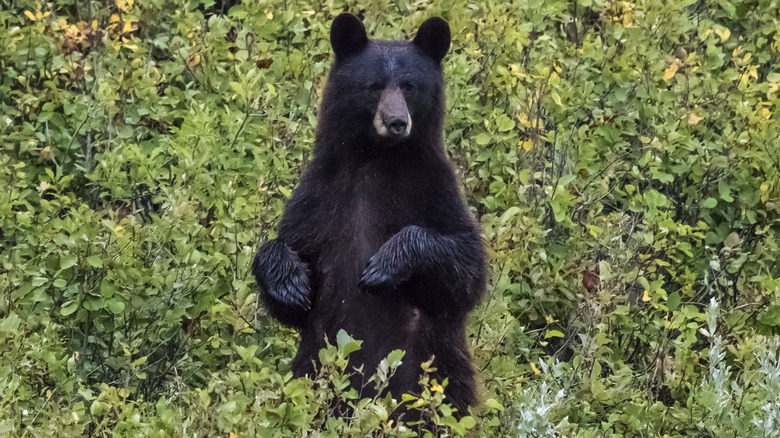West Virginia's New River Gorge National Park Is Far More Dangerous Than Meets The Eye
America's national parks invite people to explore the outdoors. They also protect unique landscapes, from the red rocks of Arches National Park to the lush, otherworldly forests of Olympic National Park. While the numerous natural wonders located within these spots may understandably leave sightseers awestruck, keep in mind that national parks can be more dangerous than meets the eye. This fact is especially important to remember when visiting West Virginia's New River Gorge National Park & Preserve.
Using National Park Service (NPS) data, multiple analyses have identified this under-the-radar national park as a notably deadly destination. Like at many parks, drownings are a key concern at New River Gorge. The New River's waters are risky for a few distinct reasons, but they're not the only potential danger at this park. Though drownings account for a significant portion of New River Gorge deaths, conditions such as tricky terrain and challenging climbs can also impact visitor safety. Prepare yourself for these conditions by reading up on what to expect during a park visit.
That said, before you get too worried about your safety, consider this important message from the NPS. "Parks have hazards. Hazards are potential sources of harm. Some hazards, like wildlife, rocky terrain, heat, high elevation, rip currents, naturally exist in the environment at the park," the NPS writes. "Sometimes the environment and the hazards are part of the thrill and adventure that you seek. Our goal is to help you learn how to recognize hazards and reduce your risk of illness, injury, or death during your visit."
The New River can flow quickly and unpredictably
Some people know the New River as one of America's oldest rivers. Those who have wrestled with this waterway's quickest currents may see it a little differently, though. While you probably won't find the New River on lists of the country's fastest rivers, it can still endanger visitors due to fluctuating water levels.
Described by the NPS as "highly complex and chaotic," the New River can easily confound visitors. Some spots, like Stone Cliff Beach, are tranquil enough for safe swimming. Meanwhile, areas where the channel narrows see much faster currents, especially during floods. The New River adds to this chaos with the occasional whirlpool.
However, as long as you prepare for these conditions, you can still safely enjoy a day on the river. Start by bringing a personal flotation device (aka lifejacket); it could make the difference between life and death on the New River. Other helpful recommendations include adventuring with a partner or group, avoiding alcohol, and closely monitoring kids near/on the water.
Difficult underwater terrain and drop-offs add to the risks
Alongside confusing currents, the New River also features surprisingly steep drop-offs, craggy underwater terrain, and deep underwater holes. Surprise, a Class III rapid on the New River, is notorious for a hole so treacherous that even seasoned rafters are warned away from it. As this rapid's name implies, rafters often don't notice any warning signs until they're face to face with Surprise's hydraulic hazards. Of course, Surprise isn't the New River's only rapid known for such difficult conditions. While sometimes classified as a warm-up spot, Stripper's Rapid features a hole so deep that it's developed a reputation for making rafters lose their paddles while trying to navigate the area. Further adding to the danger here are pinning rocks that can trap people underwater.
To mitigate the risks posed by these issues, the NPS advises visitors to carefully plan and research any paddling or boating excursions. This planning process should include a thoughtful evaluation of the river's conditions and your skill level. Pack a first aid kit for any emergencies, and bring water shoes to avoid cutting your feet on rough underwater terrain. Those unfamiliar with this part of West Virginia may also want to consider coordinating with local outfitters who can safely guide them down the river.
Difficult rock climbing routes can lead to deadly falls
Off the water, New River Gorge National Park visitors can appreciate the region's ancient geological wonders with a bit of rock climbing on over 1,400 established routes. However, like most outdoor activities, climbing too comes with risks. At New River Gorge, these risks are influenced by a few unique features. Of these features, one of the most important to remember is that this park primarily consists of climbs graded Class 5 and above. While highly experienced climbers may have a field day navigating these challenging routes, the region is not suited for beginners. Past climbers here have fallen from heights of up to 60 feet, either dying or seriously injuring themselves as a result. When paired with unpredictable local weather, New River Gorge's climbs can be deadly.
If you're skilled and experienced enough to feel confident attempting this park's climbing routes, prepare for a fun and safe outing by remembering these tips. First, familiarize yourself with the routes you want to climb. Plan your trip with crowd and weather conditions in mind, and read up on the park's climbing regulations. Before arriving, check all of your gear (including the always essential helmet) to ensure it's in good condition. In addition to your gear, bring a buddy or group with you to climb. As with many outdoor pursuits, climbing is not an activity to embark on by yourself.
Rough Appalachian terrain may challenge hikers
Curious to follow the West Virginia Waterfall Trail through New River Gorge National Park? While hiking can be a wonderfully accessible and beginner-friendly way to enjoy the outdoors, hikers should still understand and prepare for potential hazards.
Located entirely within the Appalachian Mountains, New River Gorge hosts trails that range from easy, smooth strolls to steep, 17-mile treks. Though the park's calm forest paths may include few risks outside of tripping over roots, other trails can be more daunting. Consider, for example, the Endless Wall Trail. While less than 5 miles long roundtrip, this route features uneven rock- and root-filled terrain, occasionally muddy sections, and cliff edges. At least one hiker has been found dead near this trail's scenic Diamond Point Overlook, and others have been injured.
Still, there's no need to avoid New River Gorge's fun hikes. Visitors just need to review some hiking safety measures to protect their well-being. First, come prepared with the proper equipment. Check the weather to help inform your clothing choices before heading out, wear reliable hiking boots that can handle Appalachian terrain, and review this guide to the best (and safest) hiking gear for everything from socks to trekking poles. Also, pack plenty of water to avoid dehydration. Prone to getting lost? Pick up a trail map from the park's visitor center, and bring a GPS or compass to help guide your way.
Wild critters big and small roam the park
Spotting an animal in its natural habitat can be the highlight of any national park outing; New River Gorge National Park is no exception. Home to over 180 bird species, 65 mammal species, 40 reptile species, and 50 amphibian species, the region boasts a bounty of critters. These animals range from big guys like the black bear (West Virginia's state animal) to small, scuttling rodents like the Allegheny woodrat. Local wildlife also includes tinier beings, like spiders, ticks, and mosquitoes. While spider bites and bear attacks aren't particularly significant causes for concern at New River Gorge, a few tips can further reduce potential risks.
When it comes to spiders, prevent bites by wearing gloves and not reaching under leaves and rocks or into crevices where spiders may lurk. If you get bitten, remember what the spider looked like. Though the park only has two kinds of poisonous spiders (brown recluses and black widows), knowing which one bit you can help medical professionals properly treat the area. For tick prevention, wear light-colored clothing that covers as much skin as possible. Light-colored clothing shows ticks more easily than dark clothing does, and minimizing exposed skin gives ticks less opportunity to latch. Snakes also thrive at this park, and two (the timber rattlesnake and northern copperhead) are venomous. Avoid bites by not veering off marked trails, giving snakes their space, and keeping pets leashed.
Worried about black bears, too? While only occasionally seen within the park, they can be dealt with by following these tips on what to do if you run into a bear while hiking.
